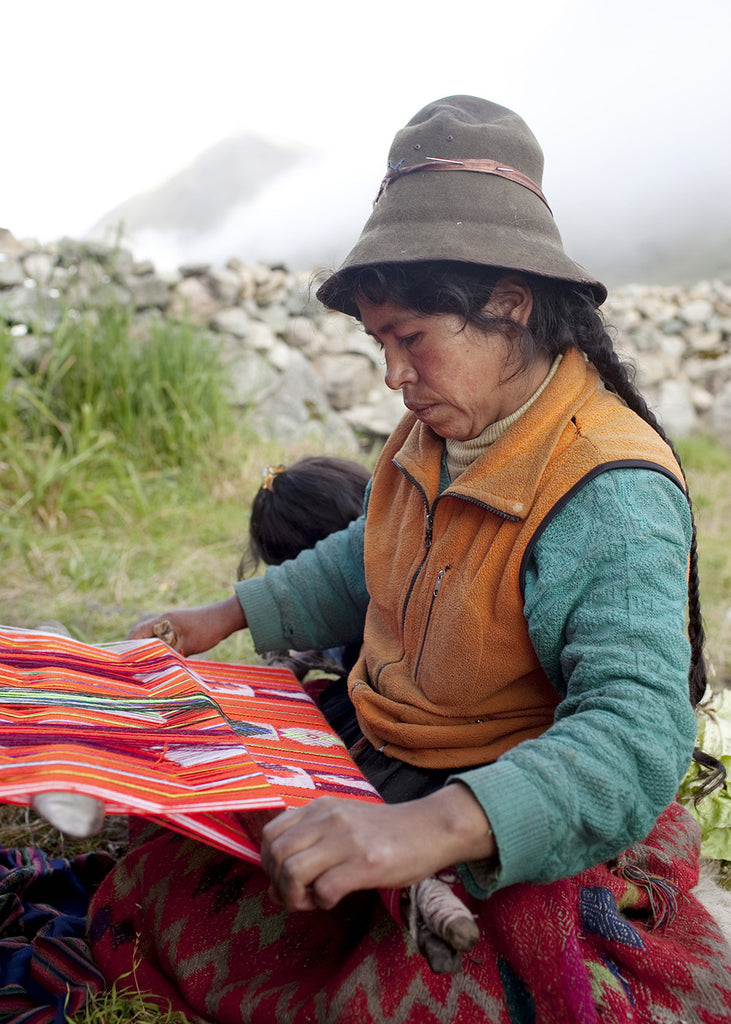
Part of our mission at Threads of Peru is to spread knowledge to the public about traditional Quechua weaving traditions, including its history, significance and techniques. In order to understand the “how” of weaving on a backstrap loom – the principal form of weaving done in the Andean highlands – we first need to understand some of the basic terminology.

Photo by Lizz Giordano
The definition of weaving is the interlacing of a set of warp with a set of weft by some means of tensioning the warp, and using a device to open the shed (i.e., to make a space) through which to pass the weft.
The warp is the set of yarns that are kept under tension, while the weft are the transverse yarns that are passed over and under the warp. All of the warps run in the same direction, as do the wefts; warp and weft, however, run perpendicular to each other.

Photo by Lizz Giordano
In backstrap loom weaving, one end of the warp yarns is attached to a fixed object such as a stake in the ground or a tree, while the other end is attached to the weaver by means of a strap that goes around the waist. In this way, the tension in the yarns is controlled by the weaver’s body: if the weaver leans forward, the tension is reduced and the yarns go slack; if she leans back, the yarns are held taught. These subtle movements in the weaver’s position allow her to manipulate the yarns in order to form the design while ultimately producing a finished textile that is even and tightly woven.

Photo by Lizz Giordano
The majority of textiles produced on the backstrap loom in the Andes are warp-faced textiles; that is, the colours visible in the finished textile correspond to the colours of the warp yarns, and the weft is completely hidden. The patterns are likewise formed by manipulating only the warp yarns: picking up certain warp yarns while simultaneously dropping others. This is the exact opposite of, for example, tapestry weaving, where instead the weft yarns completely cover the warp in order to form the pattern.

Photo by Lizz Giordano
There are a number of different ways to create patterns in warp-faced textiles, but one of the most common in traditional Quechua weaving is the technique known as complementary weave. When the warp yarns are measured out prior to weaving (in a process known as warping), the plain areas – areas of solid colour and no patterns (called the pampa) – consist of rows of single yarns (just one colour), while the patterned areas (calledpallay, which means “to pick up” in Quechua) consist of rows of double yarns: two balls of yarn of contrasting colours are simultaneously measured out. This creates a warp with sections of contrasting yarns: one colour on one side, and the opposite colour on the other.

Photo by Lizz Giordano
When weaving, in order to create the pattern or pallay, certain yarns are “picked up”, while the weaver lets drop its complement (the matching yarn in the opposite colour) to the bottom. The result is the identical pattern on both sides of the textile, but in opposite colours.

Photo by Lizz Giordano
This is a fairly slow and painstaking process! But it allows for the creation of some of the most varied and intricate woven patterns. It also requires a great deal of skill: traditional Quechua weavers not only master the technique of ordering and manipulating the warp yarns to create patterns, they learn and memorize up to 50 different pattern sequences, some extremely complex…and then incorporate several of them into a single weaving, simultaneously orchestrating a series of unique patterns into one unified whole, a remarkable feat with stunning results.

